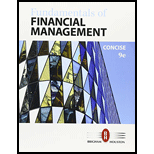
Fundamentals of Financial Management, Concise Edition
9th Edition
ISBN: 9781337087544
Author: Eugene F. Brigham, Joel F. Houston
Publisher: Cengage Learning
expand_more
expand_more
format_list_bulleted
Textbook Question
Chapter 8, Problem 8DQ
Beta pf CPB company
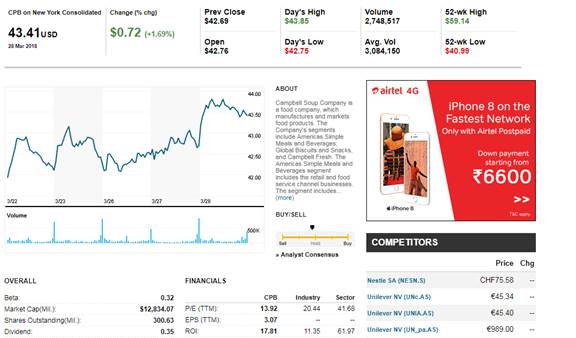
Beta of the MSI Company is 0.19.
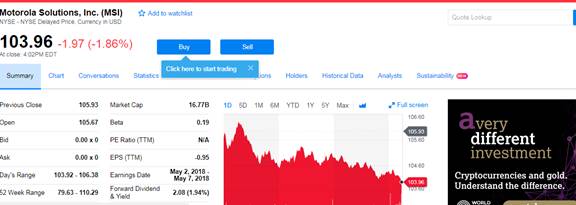
The beta of TIF Company is 1.76.
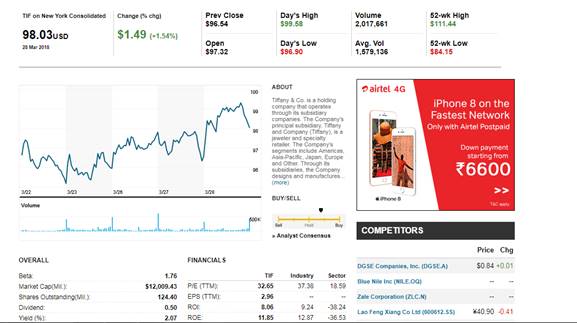
Repeat the same exercise for each of the three remaining companies. Do the reported betas confirm your earlier intuition? In general, do you find that the higher-beta stocks tend to do better in up markets and worse in down markets? Explain.
Expert Solution & Answer
Want to see the full answer?
Check out a sample textbook solution
Students have asked these similar questions
Wildcat, Incorporated, has estimated sales (in millions) for the next four quarters as follows:
Q1
Q2
Q3
Sales $ 195 $ 215 $ 235
Q4
$ 265
Sales for the first quarter of the following year are projected at $210 million. Accounts receivable at the
beginning of the year were $83 million. Wildcat has a 45-day collection period.
Wildcat's purchases from suppliers in a quarter are equal to 50 percent of the next quarter's forecast sales, and
suppliers are normally paid in 36 days. Wages, taxes, and other expenses run about 20 percent of sales.
Interest and dividends are $18 million per quarter.
Wildcat plans a major capital outlay in the second quarter of $98 million. Finally, the company started the year
with a $84 million cash balance and wishes to maintain a $40 million minimum balance.
a-1. Assume that Wildcat can borrow any needed funds on a short-term basis at a rate of 3 percent per quarter
and can invest any excess funds in short-term marketable securities at a rate of 2 percent per…
Consider the following two bonds:
Bond A
Bond B
Face value
$1,000
$1,000
Coupon rate (annual)
8%
8%
YTM
9%
7%
Maturity
10 years
10 years
Price (PV)
?
?
Calculate the price for each bond. What is the primary factor affecting the prices of the bonds? Indicate which bond is premium and which one is discount. Is there any relationship between the YTM and the coupon rate in case of premium/discount bonds?
Now, consider the following two bonds:
Bond X
Bond Y
Face value
$1,000
$1,000
Coupon rate (annual)
8%
8%
YTM
11%
11%
Maturity
5 years
10 years
Price (PV)
?
?
Calculate the price for each bond. What is the relationship between bond price and maturity, all else equal?
A bond with a par value of $1,000 and a maturity of 8 years is selling for $925. If the annual coupon rate is 7%, what’s the yield on the bond? What would be the yield if the bond had semiannual payments?…
Don't used hand raiting
Chapter 8 Solutions
Fundamentals of Financial Management, Concise Edition
Ch. 8 - Suppose you owned a portfolio consisting of...Ch. 8 - Prob. 2QCh. 8 - Prob. 3QCh. 8 - Is it possible to construct a portfolio of...Ch. 8 - Stock A has an expected return of 7%, a standard...Ch. 8 - A stock had a 12% return last year, a year when...Ch. 8 - If investors aversion to risk increased, would the...Ch. 8 - Prob. 8QCh. 8 - In Chapter 7, we saw that if the market interest...Ch. 8 - Prob. 1P
Ch. 8 - PORTFOLIO BETA An individual has 20,000 invested...Ch. 8 - Prob. 3PCh. 8 - Prob. 4PCh. 8 - BETA AND REQUIRED RATE OF RETURN A stock has a...Ch. 8 - EXPECTED RETURNS Stocks A and B have the following...Ch. 8 - PORTFOLIO REQUIRED RETURN Suppose you are the...Ch. 8 - Prob. 8PCh. 8 - REQUIRED RATE OF RETURN Stock R has a beta of 2.0,...Ch. 8 - Prob. 10PCh. 8 - CAPM AND REQUIRED RETURN Calculate the required...Ch. 8 - REQUIRED RATE OF RETURN Suppose rRF = 4%, rM =...Ch. 8 - CAPM, PORTFOLIO RISK, AND RETURN Consider the...Ch. 8 - PORTFOLIO BETA Suppose you held a diversified...Ch. 8 - Prob. 15PCh. 8 - CAPM AND PORTFOLIO RETURN You have been managing a...Ch. 8 - PORTFOLIO BETA A mutual fund manager has a 20...Ch. 8 - EXPECTED RETURNS Suppose you won the lottery and...Ch. 8 - EVALUATING RISK AND RETURN Stock X has a 10%...Ch. 8 - REALIZED RATES OF RETURN Stocks A and 13 have the...Ch. 8 - SECURITY MARKET LINE You plan to invest in the...Ch. 8 - Prob. 22SPCh. 8 - Prob. 23ICCh. 8 - Prob. 1DQCh. 8 - Prob. 2DQCh. 8 - Prob. 3DQCh. 8 - Select one of the four stocks listed in Question 3...Ch. 8 - Go back to the summary page to see an estimate of...Ch. 8 - Prob. 6DQCh. 8 - Prob. 7DQCh. 8 - Beta pf CPB company Beta of the MSI Company is...
Knowledge Booster
Learn more about
Need a deep-dive on the concept behind this application? Look no further. Learn more about this topic, finance and related others by exploring similar questions and additional content below.Similar questions
- Don't used Ai solutionarrow_forwardAssume an investor deposits $116,000 in a professionally managed account. One year later, the account has grown in value to $136,000 and the investor withdraws $43,000. At the end of the second year, the account value is $107,000. No other additions or withdrawals were made. During the same two years, the risk-free rate remained constant at 3.94 percent and a relevant benchmark earned 9.58 percent the first year and 6.00 percent the second. Calculate geometric average of holding period returns over two years. (You need to calculate IRR of cash flows over two years.) Round the answer to two decimals in percentage form.arrow_forwardPlease help with these questions.arrow_forward
- Please help with these questionsarrow_forwardIn 1895, the first U.S. Putting Green Championship was held. The winner's prize money was $170. In 2022, the winner's check was $3,950,000. a. What was the percentage increase per year in the winner's check over this period? Note: Do not round intermediate calculations and enter your answer as a percent rounded to 2 decimal places, e.g., 32.16. b. If the winner's prize increases at the same rate, what will it be in 2053? Note: Do not round intermediate calculations and enter your answer as a percent rounded to 2 decimal places, e.g., 32.16. a. Increase per year b. Winners prize in 2053 %arrow_forwardDerek plans to retire on his 65th birthday. However, he plans to work part-time until he turns 73.00. During these years of part-time work, he will neither make deposits to nor take withdrawals from his retirement account. Exactly one year after the day he turns 73.0 when he fully retires, he will begin to make annual withdrawals of $183,008.00 from his retirement account until he turns 94.00. After this final withdrawal, he wants $1.52 million remaining in his account. He he will make contributions to his retirement account from his 26th birthday to his 65th birthday. To reach his goal, what must the contributions be? Assume a 6.00% interest rate. Round to 2 decimal places.arrow_forward
- Derek plans to retire on his 65th birthday. However, he plans to work part-time until he turns 71.00. During these years of part-time work, he will neither make deposits to nor take withdrawals from his retirement account. Exactly one year after the day he turns 71.0 when he fully retires, he will begin to make annual withdrawals of $177,333.00 from his retirement account until he turns 94.00. He he will make contributions to his retirement account from his 26th birthday to his 65th birthday. To reach his goal, what must the contributions be? Assume a 9.00% interest rate. Submit Answer format: Currency: Round to: 2 decimal places.arrow_forwardDerek plans to retire on his 65th birthday. However, he plans to work part-time until he turns 72.00. During these years of part-time work, he will neither make deposits to nor take withdrawals from his retirement account. Exactly one year after the day he turns 72.0 when he fully retires, he will wants to have $3,104,476.00 in his retirement account. He he will make contributions to his retirement account from his 26th birthday to his 65th birthday. To reach his goal, what must the contributions be? Assume a 8.00% interest rate. Submit Answer format: Currency: Round to: 2 decimal places.arrow_forwardBanking and finance sector ma job kaise payearrow_forward
arrow_back_ios
SEE MORE QUESTIONS
arrow_forward_ios
Recommended textbooks for you
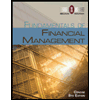 Fundamentals of Financial Management, Concise Edi...FinanceISBN:9781285065137Author:Eugene F. Brigham, Joel F. HoustonPublisher:Cengage Learning
Fundamentals of Financial Management, Concise Edi...FinanceISBN:9781285065137Author:Eugene F. Brigham, Joel F. HoustonPublisher:Cengage Learning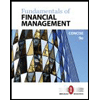 Fundamentals of Financial Management, Concise Edi...FinanceISBN:9781305635937Author:Eugene F. Brigham, Joel F. HoustonPublisher:Cengage Learning
Fundamentals of Financial Management, Concise Edi...FinanceISBN:9781305635937Author:Eugene F. Brigham, Joel F. HoustonPublisher:Cengage Learning

Fundamentals of Financial Management, Concise Edi...
Finance
ISBN:9781285065137
Author:Eugene F. Brigham, Joel F. Houston
Publisher:Cengage Learning

Fundamentals of Financial Management, Concise Edi...
Finance
ISBN:9781305635937
Author:Eugene F. Brigham, Joel F. Houston
Publisher:Cengage Learning
Financial leverage explained; Author: The Finance story teller;https://www.youtube.com/watch?v=GESzfA9odgE;License: Standard YouTube License, CC-BY